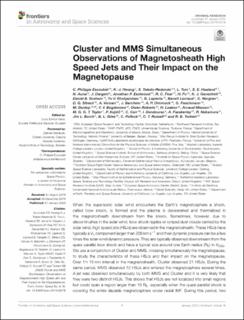| dc.description.abstract | When the supersonic solar wind encounters the Earth's magnetosphere a shock, called bow shock, is formed and the plasma is decelerated and thermalized in the magnetosheath downstream from the shock. Sometimes, however, due to discontinuities in the solar wind, bow shock ripples or ionized dust clouds carried by the solar wind, high speed jets (HSJs) are observed in the magnetosheath. These HSJs have typically a Vx component larger than 200 km s−1 and their dynamic pressure can be a few times the solar wind dynamic pressure. They are typically observed downstream from the quasi-parallel bow shock and have a typical size around one Earth radius (RE) in XGSE. We use a conjunction of Cluster and MMS, crossing simultaneously the magnetopause, to study the characteristics of these HSJs and their impact on the magnetopause. Over 1 h 15 min interval in the magnetosheath, Cluster observed 21 HSJs. During the same period, MMS observed 12 HSJs and entered the magnetosphere several times. A jet was observed simultaneously by both MMS and Cluster and it is very likely that they were two distinct HSJs. This shows that HSJs are not localized into small regions but could span a region larger than 10 RE, especially when the quasi-parallel shock is covering the entire dayside magnetosphere under radial IMF. During this period, two and six magnetopause crossings were observed, respectively, on Cluster and MMS with a significant angle between the observation and the expected normal deduced from models. The angles observed range between from 11° up to 114°. One inbound magnetopause crossing observed by Cluster (magnetopause moving out at 142 km s−1) was observed simultaneous to an outbound magnetopause crossing observed by MMS (magnetopause moving in at −83 km s−1), showing that the magnetopause can have multiple local indentation places, most likely independent from each other. Under the continuous impacts of HSJs, the magnetopause is deformed significantly and can even move in opposite directions at different places. It can therefore not be considered as a smooth surface anymore but more as surface full of local indents. Four dust impacts were observed on MMS, although not at the time when HSJs are observed, showing that dust clouds would have been present during the observations. No dust cloud in the form of Interplanetary Field Enhancements was however observed in the solar wind which may exclude large clouds of dust as a cause of HSJs. Radial IMF and Alfvén Mach number above 10 would fulfill the criteria for the creation of bow shock ripples and the subsequent crossing of HSJs in the magnetosheath. | en_US |

